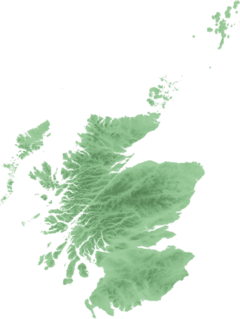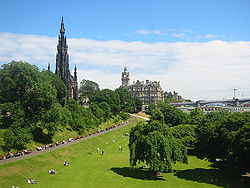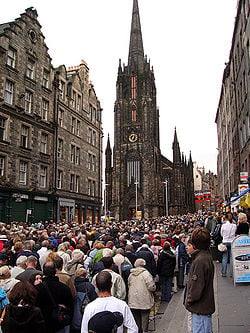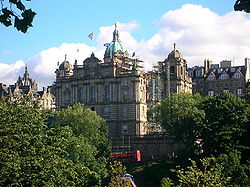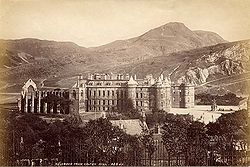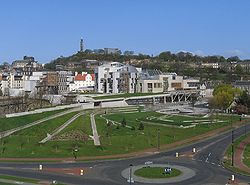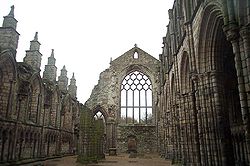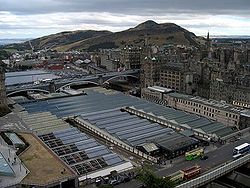Difference between revisions of "Edinburgh" - New World Encyclopedia
Mike Butler (talk | contribs) |
Mike Butler (talk | contribs) |
||
| Line 352: | Line 352: | ||
*[http://www.henniker.org.uk/ 1000s of local photos by Dave Henniker] | *[http://www.henniker.org.uk/ 1000s of local photos by Dave Henniker] | ||
*[http://www.edinburghsucks.com/ A popular alternative view of Edinburgh Politics] | *[http://www.edinburghsucks.com/ A popular alternative view of Edinburgh Politics] | ||
| − | |||
| − | |||
| − | |||
| − | |||
| − | |||
| − | |||
| − | |||
| − | |||
| − | |||
| − | |||
| − | |||
| − | |||
| − | |||
| − | |||
| − | |||
[[Category:Geography]] | [[Category:Geography]] | ||
Revision as of 00:57, 14 October 2008
| City of Edinburgh | |
| Scottish Gaelic: Dùn Èideann | |
| Scots: Edinburgh, Embra, Embro, Edinburrie | |
| Auld Reekie, Athens of the North, Capital of Scotland | |
|
File:EdinburghFromCastle.jpg
|
|
|
City of Edinburgh shown within Scotland | |
| Area[1] | 100 sq mi (259 km²) |
|---|---|
| Population | 457,830 (30 June 2005) |
| Urban | 1,250,000 |
| OS grid reference | |
| - London | 332 miles (535 km) SSE |
| Council area | City of Edinburgh |
| Lieutenancy area | Edinburgh |
| Constituent country | Scotland |
| Sovereign state | United Kingdom |
| Post town | EDINBURGH |
| Postcode district | EH1-EH13; EH14 (part); EH15-EH17 |
| Dialling code | 0131 |
| Police | |
| Fire | |
| Ambulance | Scottish |
| European Parliament | Scotland |
| UK Parliament | Edinburgh South |
| Edinburgh West | |
| Edinburgh South West | |
| Edinburgh North and Leith Edinburgh East |
|
| Scottish Parliament | Edinburgh North and Leith |
| Edinburgh Central | |
| Edinburgh East and Musselburgh Edinburgh Pentlands Edinburgh South Edinburgh West Lothians |
|
| List of places: UK • Scotland | |
Edinburgh (Template:Audio2, pronounced /ˈɛdɪnb(ə)rə/; Scottish Gaelic: Dùn Èideann), located in the south-east of Scotland, is the capital of Scotland and is its second largest city after Glasgow.
Owing to its rugged setting and vast collection of Medieval and Georgian architecture, including numerous stone tenements, it is often considered one of the most picturesque cities in Europe.
It forms the City of Edinburgh council area; the city council area includes urban Edinburgh and a 30-square-mile (78 km²) rural area.
It has been capital of Scotland since 1437 (replacing Scone) and is the seat of the Scottish Parliament. The city was one of the major centres of the Enlightenment, led by the University of Edinburgh, earning it the nickname Athens of the North. The Old Town and New Town districts of Edinburgh were listed as a UNESCO World Heritage Site in 1995. There are over 4500 listed buildings within the city.[2] In the census of 2001, Edinburgh had a total resident population of 448,625.
The city is one of Europe's major tourist destinations, attracting 1 million visitors a year, and is the second most visited tourist destination in the United Kingdom, after London.[3]
Geography
The origin of the city's name in English is understood to come from the Brythonic Din Eidyn (Fort of Eidyn) from the time when it was a Gododdin hillfort.[4] It came to be known to the English, the Bernician Angles, as Edin-burh. The burgh means "fortress" or "walled group of buildings", while Edin is untranslated.
The city is affectionately nicknamed Auld Reekie[5] (Scots for Old Smoky), because when buildings were heated by coal and wood fires, chimneys would spew thick columns of smoke into the air. Some have called Edinburgh the Athens of the North and Auld Greekie for its intellectual history, and for its topography, with the Old Town of Edinburgh performing a similar role to the Athenian Acropolis.[6] Edinburgh is also known by several Latin names; Aneda or Edinensis, the latter can be seen inscribed on many educational buildings.[7][8][9][10][11]
Edinburgh has also been known as Dunedin, deriving from the Scottish Gaelic, Dùn Èideann. Dunedin, New Zealand, was originally called "New Edinburgh" and is still nicknamed the "Edinburgh of the South". The Scots poets Robert Burns and Robert Fergusson sometimes used the city's Latin name, Edina. Ben Jonson described it as Britain's other eye,[12] and Sir Walter Scott referred to the city as yon Empress of the North.[13]
Edinburgh occupies seven miles (11km) of the north-facing slope on the southern shore of the Firth of Forth, which is an arm of the North Sea reaching west into the Scottish Lowlands. Much of the city lies among craggy upthrusts of lava and hills — the valleys between were scoured by Pleistocene Epoch glacial action.
Arthur’s Seat has an elevation of 823 feet (251 metres), while Castle Rock, a basalt plug sealing an extinct volcano, stands 250 feet (76 metres) above the valley floor and is crowned by the famous Edinburgh Castle.
Edinburgh has a temperate maritime climate, which is relatively mild despite its northerly latitude. Winters are especially mild, with the average maximum daytime temperature in January of 43.2°F (6.2°C), rising to an average maximum of around 65.8°F (18.8°C) in July. The proximity of the city to the sea mitigates any large variations in temperature or extremes of climate. Edinburgh is renowned as a windy city, with the prevailing wind direction coming from the south-west which is associated with warm, unstable air from the Gulf Stream. Mean annual precipitation is 26.3 inches (668mm).
The historic centre of Edinburgh is divided into two by the broad green swath of Princes Street Gardens. To the south the view is dominated by Edinburgh Castle, perched atop the extinct volcanic crag, and the long sweep of the Old Town trailing after it along the ridge. To the north lies Princes Street and the New Town. The gardens were begun in 1816 on bogland which had once been the Nor Loch. To the immediate west of the castle lies the financial district, housing insurance and banking buildings. Probably the most noticeable building here is the circular sandstone building that is the Edinburgh International Conference Centre.
The Old Town has preserved its medieval plan and many Reformation-era buildings. One end is closed by the castle and the main artery, the Royal Mile, leads away from it; minor streets (called closes or wynds) lead downhill on either side of the main spine in a herringbone pattern. Large squares mark the location of markets or surround public buildings such as St Giles Cathedral and the Law Courts. Other notable places nearby include the Royal Museum of Scotland, Surgeons' Hall and McEwan Hall.
Due to space restrictions, the Old Town became home to some of the earliest "high rise" residential buildings. Multi-storey dwellings known as lands were the norm from the 1500s onwards with 10 and 11 stories being typical and one even reaching 14 stories. Additionally, numerous vaults below street level were inhabited to accommodate the influx of (mainly Irish) immigrants during the Industrial Revolution. These continue to fuel legends of an underground city to this day. Today there are tours of Edinburgh which take you into the underground city, which is being excavated.[14]
In 1766, a competition to design the New Town was won by James Craig, a 22-year-old architect. The plan that was built created a rigid, ordered grid, which fitted well with enlightenment ideas of rationality. The principal street was to be George Street, which follows the natural ridge to the north of the Old Town. Either side of it are the other main streets of Princes Street and Queen Street. Princes Street has since become the main shopping street in Edinburgh, and few Georgian buildings survive on it. Linking these streets were a series of perpendicular streets. At the east and west ends are St. Andrew Square and Charlotte Square respectively.
Sitting in the glen between the Old and New Towns was the Nor' Loch, which had been both the city's water supply and place for dumping sewage. Princes Street Gardens were created. Excess soil from the construction of the buildings was dumped into the loch, creating what became The Mound. In the mid-19th century the National Gallery of Scotland and Royal Scottish Academy Building were built on The Mound, and tunnels to Waverley Station driven through it.
The New Town was extended greatly, although the grid pattern was not maintained, but rather a more picturesque layout was created. Today the New Town is considered by many to be one of the finest examples of Georgian architecture and planning in the world.
A popular residential part of the city is its south side, and includes numerous well-regarded state and private schools. The central University of Edinburgh campus is based around George Square just north of Marchmont and the Meadows, and Napier University has major campuses around Merchiston & Morningside), and with festival-goers.
Leith, the port of Edinburgh, still retains a separate identity from Edinburgh. With the redevelopment of Leith, Edinburgh has gained the business of a number of cruise liner companies which now provide cruises to Norway, Sweden, Denmark, Germany and the Netherlands. Leith also has the Royal Yacht Britannia, berthed behind the Ocean Terminal and Easter Road, the home ground of Hibernian.
History
See Timeline of Edinburgh history
Edinburgh started as a fort named Castle Rock (an easily defended position). However, in the 7th century, Edwin of Northumbria, a Angle of Deira (the southern part of what became the Kingdom of Northumbria, captured this location and named it Eiden's burgh (burgh being an old word for fort). Edwin made Edinburgh his capital and from it carved out a kingdom, which would come to stretch as far south as river Humber in Modern day England, known as Northumbria/Bernicia. After the murder of St. Oswald King of Northumbria, Edinburgh fell under the control of the Danelaw. In the 10th century, with the collapse of the Danelaw the Scots & Picts again recaptured this position. Then in the 12th century a small town flourished at the base of the castle known as Edinburgh, along side which another community rose up to the East around the Abbey of Holyrood, known as Holyrood, together in the 13th century these became Royal Burghs. In consequence to Edinburgh's earlier Anglo-Saxon rule, Edinburgh and the Border counties lay in a disputed zone between England and Scotland, England claiming all Anglo-Saxon Domains as English territory, and Scotland claiming all territory as far south as Hadrians Wall, the result being a long series of border wars and clashes, which often left Edinburgh Castle under English control. It was not until the 15th century when Edinburgh remained for the most firmly under Scottish control, that King James IV of Scotland undertook, to move the Royal Court from Stirling to Holyrood, making Edinburgh by proxy Scotland's capital.
As Edinburgh remained under Scottish Rule, with the nearby port and Royal Burgh of Leith, Edinburgh flourished both economically and culturally. In 1603, following King James VI's accession to the English and Irish Thrones, James VI instituted the first executive Parliament of Scotland which met in the Great Hall of Edinburgh Castle, later finding a home in the Tolbooth, before moving to purpose-built Parliament House, Edinburgh, which is now home to the Supreme Courts of Scotland[citation needed].
In 1639 disputes over the planned merger, between the Presbyterian Church and the Anglican Church, and the demands by Charles I, to reunify the divided St. Giles' Cathedral, led to the Bishops Wars, which in turn led to the English Civil War, and the eventual the occupation of Edinburgh by Commonwealth forces of Oliver Cromwell.
In the 1670s King Charles II commissioned the rebuilding of Holyrood Palace.
During the last Jacobite rebellion Edinburgh was occupied by Jacobite forces, after the retreat of Jacobite forces from Derby it was re-occupied by British forces under the command of the Prince William, Duke of Cumberland. Following the defeat of Jacobites there was a long period of reprisals and pacification.
At this time, the Hanoverian Monarch wished to stamp his identity on Edinburgh and new developments to the North of the castle were named in honour of the King and his Family; George Street, Frederick Street, Hanover Street, Queen Street, Prince’s Street, Castle Street and with control of the ‘Rose’ of England and the ‘Thistle’ of Scotland these names were also allocated to Streets. The original plan for this build was to be constructed in the form of King James IV’s Union Flag and this shape can be detected when viewing the layout of the aforementioned streets from above.
Out of the mess left behind by the consequences of the Jacobite rebellion came a number of Scottish Intellectuals, many from Edinburgh, including Adam Smith, who felt it was time to put the history of the Clans of Scotland behind them and that this was a time for Scotland to modernise. They promoted the idea of Britishness, and led Great Britain and the British Empire into a golden age of economic and social reform and prosperity. It was during this period, that Edinburgh expanded beyond the limits of its city walls, with the creation of the New Town, following the draining of the Nor Loch, which has since become Castle Gardens. Edinburgh became a major cultural centre, earning it the nickname "Athens of the North", both due to the Greco-Roman style of the New Towns' architecture, as well as the rise of the Scottish/British intellectual elite in the city, who were increasingly leading both British and European intellectual thought.
In the 19th century Edinburgh like many cities industrialised, but most of this was undertaken in Leith, which meant that Edinburgh as a whole did not grow greatly in size. Glasgow soon replaced it as the largest and most prosperous city in Scotland, becoming the industrial, commercial and trade centre, whilst Edinburgh remained almost purely Scotland's intellectual and cultural centre, which it remains to this day as one of the greatest cultural centres of the UK.
Government
As part of the United Kingdom, Scotland is a liberal democracy and a constitutional monarchy. In elections to the House of Commons of the Parliament of the United Kingdom (Westminster), the city area is divided between five first-past-the-post constituencies. As capital of Scotland, Edinburgh is host to the national unicameral legislature, the Scottish Parliament. The Scottish Parliament Building, in the Holyrood area of Edinburgh, opened in September 2004. The devolved Scottish Parliament is responsible for health, education, housing, economic development, regional transport, the environment, and agriculture. Bute House on Charlotte Square is the official residence of the First Minister of Scotland. For elections to the European Parliament, Edinburgh is within the Scotland constituency.
Edinburgh constitutes one of the 32 council areas of Scotland and, as such, is represented by the City of Edinburgh Council, a local authority composed of 58 elected councillors, each representing a multi-member electoral ward in the city. The council is led by the Lord Provost. Elections to the council are held on a four year cycle, the last on May 3, 2007. Councillors are elected from multi-member wards, each electing three or four councillors by the single transferable vote system, to produce a form of proportional representation.
Economy
Edinburgh has the strongest economy of any city in the UK outside London — the city's GDP per capita was measured at US$55,000 in 2004, compared with London's US$72,500 in 2005. The economy of Edinburgh is largely based around the services sector — centred around banking, financial services, higher education, and tourism. As the centre of Scotland's devolved government, as well as its legal system, the public sector plays a central role in the economy of Edinburgh with many departments of the Scottish Government located in the city. Other major employers include NHS Scotland and local government administration. Education and health, finance and business services, retailing and tourism are the largest employers.[15]
Banking has been a part of the economic life of Edinburgh for over 300 years with the invention of capitalism in the city, with the establishment of the Bank of Scotland by an act of the original Parliament of Scotland in 1695. Their headquarters are on the Mound, overlooking Princes Street. Today, together with the burgeoning financial services industry, with particular strengths in insurance and investment underpinned by the presence of Edinburgh based firms such as Scottish Widows and Standard Life, Edinburgh has emerged as Europe's sixth largest financial centre.[16] The Royal Bank of Scotland, which is the fifth largest in the world by market capitalisation, opened their new global headquarters at Gogarburn in the west of the city in October 2005; their registered office remains in St. Andrew Square.
Tourism is an important economic mainstay in the city. As a World Heritage Site, tourists come to visit such historical sites as Edinburgh Castle, the Palace of Holyroodhouse and the Georgian New Town. This is augmented in August of each year with the presence of the Edinburgh Festivals, which bring in large numbers of visitors, generating in excess of £100m for the Edinburgh economy.[17]
Manufacturing has never had as strong presence in Edinburgh compared with Glasgow; however brewing, publishing, and nowadays electronics have maintained a foothold in the city. While brewing has been in decline in recent years, with the closure of the McEwan's Brewery in 2005, Caledonian Brewery remains as the largest, with Scottish and Newcastle retaining their headquarters in the city.
Unemployment in Edinburgh is low at 2.2 percent in 2007, which has been consistently below the Scottish average.[18]
Edinburgh has 70 post offices.
Edinburgh is a major transport hub, with arterial road and rail routes that connect the city to the rest of Scotland and with England. It is connected to the north of Scotland by the famous feats of engineering, the Forth Bridge and the Forth Road Bridge.
Most public transport trips in Edinburgh are taken by bus. Construction work began in 2007 on a light rapid transit tram line to connect Edinburgh Airport and Granton via the city centre and Leith Walk.
Edinburgh is served by Edinburgh Airport (EDI), located about eight miles (13km) to the west of the city, with scheduled connections to many cities in Europe and international long-haul route network.
Demographics
The City of Edinburgh council area had an estimated resident population of 463,510 in 2006.[19] The 2001 UK census reported the population to be 448,624, making the city the seventh largest in the United Kingdom.[20] The population of the greater Edinburgh area (including parts of Fife and the Scottish Borders) is 1.25 million and is projected to grow to 1.33 million by 2020. Though Edinburgh's population is ageing, a very large and transient population of young students studying at the city universities has helped to offset this demographic problem. There are estimated to be around 100,000 students studying at the various institutions of higher education in the city.[21]
Edinburgh is a cosmopolitan city, with many immigrants from all corners of the world. From walking the streets, English, Gaelic, Polish, Chinese, French, Spanish, Hindi and many others can be heard.
The main ethnic groups are: Scottish (including those of mixed English and Scottish descent and those born in Scotland of full English descent) 82 percent, English 13 percent, Polish 2 percent, Chinese (including Chinese Hong Kong) 1 percent, Indian 1 percent, and Pakistani 1 percent. The other 2 percent includes French, Spanish, Lithuanians, Australians, New Zealanders, South Africans, Chileans, Malaysians and Africans from all parts of Africa. The Leith Walk, Leith, Tollcross and the Southside districts have many Polish, Chinese and South Asian immigrants. In these areas there are many food stores and both Leith and the Southside each have a mosque. Stockbridge has many wealthy English immigrants.
The primary languages spoken in Scotland are Scottish English, (Lowland) Scots, and Scottish Gaelic.
The Church of Scotland claims the largest membership of any religious denomination in Edinburgh. Its most important and historical church is St Giles' Cathedral. In the south east of the city is the 12th century Duddingston Kirk. The Roman Catholic Church also has a sizeable presence. Its notable structures include St Mary's Cathedral at the top of Leith Walk, the Sacred Heart of Jesus, St Patrick's, St. Columba's, St Peter's and Star of the Sea.
The Free Church of Scotland (Reformed and Presbyterian) has congregations on the Royal Mile and Crosscauseway. The Scottish Episcopal Church is part of the Anglican Communion. Its centre is the resplendent St Mary's Cathedral, Palmerston Place in the west end.
There are a number of independent churches situated throughout the city, which tend to have a high percentage of student congregants and include Destiny Church, Charlotte Chapel, Carrubbers Christian Centre and Bellevue Chapel.
Edinburgh's main mosque and Islamic Centre is located on Potterow on the city's southside, near Bristo Square. It was opened in the late 1990s and the construction was largely financed by a gift from King Fahd of Saudi Arabia.[22] The first recorded presence of a Jewish community in Edinburgh dates back to the late 17th century. Edinburgh's Orthodox synagogue is located in Salisbury Road, which was opened in 1932 and can accommodate a congregation of 2000. A Liberal congregation also meets in the city. There is also a Sikh Gurdwara and Hindu Mandir in the city which are both located in the Leith district.
The Royal High School, that can can trace its roots back to 1128, is considered to be the oldest school in Scotland. The University of Edinburgh was founded by Royal Charter in 1583,[23] and is the fourth oldest university in Scotland. The Old College on South Bridge opened in the 1820s. The Royal College of Surgeons of Edinburgh and the Royal College of Physicians of Edinburgh were established by Royal Charter, in 1506 and 1681 respectively. The Trustees Drawing Academy of Edinburgh was established in 1760,[24] an institution that became the Edinburgh College of Art in 1907.
In the 1960s Heriot-Watt University and Napier Technical College were established. Heriot-Watt traces its origins to 1821, when a school for technical education of the working classes was opened. Heriot-Watt continues to have a strong reputation in engineering, and is based at Riccarton, in the west of the city.
Other colleges include Telford College, opened in 1968, and Stevenson College, opened in 1970. Basil Paterson College offers courses in languages and teaching. The Scottish Agricultural College also has a campus in south Edinburgh.
Culture
Festivals
Culturally, Edinburgh is best known for the Edinburgh Festival, although this is in fact a series of separate events, which run from the end of July until early September each year. The longest established festival is the Edinburgh International Festival, which first ran in 1947. The International Festival centres on a programme of high-profile theatre productions and classical music performances, featuring international directors, conductors, theatre companies and orchestras.
The International Festival has since been taken over in both size and popularity by the Edinburgh Fringe. What began as a programme of marginal acts has become the largest arts festival in the world, with 1867 different shows being staged in 2006, in 261 venues. Comedy is now one of the mainstays of the Fringe, with numerous notable comedians getting their 'break' here, often through receipt of the Perrier Award.
In 2008 comedy on the Edinburgh Fringe was launched as a festival within a festival, and labelled the Edinburgh Comedy Festival. Already at its inception it was the largest comedy festival in the world.[25]
Alongside these major festivals, there is also the Edinburgh Art Festival, Edinburgh International Film Festival, the Edinburgh Jazz and Blues Festival, and the Edinburgh International Book Festival. The Edge Festival (formerly known as T on the Fringe), a popular music offshoot of the Fringe, began in 2000, replacing the smaller Flux and Planet Pop series of shows. Tigerfest is an independent music festival which ran concurrently with the Fringe in 2004 and 2005 before moving to a May slot in 2006.
Running concurrently with the summer festivals, the Edinburgh Military Tattoo occupies the Castle Esplanade every night, with massed pipers and fireworks.
The Edinburgh International Science Festival is held annually in April and is one of the most popular science festivals in the world.
Celebrations

Equally famous is the annual Hogmanay celebration. Originally simply a street party held on Princes Street and the Royal Mile, the Hogmanay event has been officially organised since 1993. In 1996, over 300,000 people attended, leading to ticketing of the main street party in later years, with a limit of 100,000 tickets. Hogmanay now covers four days of processions, concerts and fireworks, with the actual street party commencing on New Years Eve. During the street party Princes Street is accessible only by ticket holders, and tickets are available for a £5 administration fee. This ticket allows access into Princes Street where there are live bands playing, food and drink stalls, and a clear view of the castle and fireworks. Alternative tickets are available for entrance into the Princes Street Gardens concert and Ceilidh for around £40, where well known artists perform live and ticket holders are invited to participate in some traditional Scottish Ceilidh dancing. The event attracts thousands of people from all over the world. On the night of 30 April, the Beltane Fire Festival takes place on Edinburgh's Calton Hill. The festival involves a procession followed by the re-enactment of scenes inspired by pagan spring fertility celebrations.
Museums and libraries
Edinburgh is home to a large number of museums and libraries, especially ones that are considered the main national institutions, the most important are the Museum of Scotland, the Royal Museum, the National Library of Scotland, National War Museum of Scotland, the Museum of Edinburgh, Museum of Childhood and the Royal Society of Edinburgh.
Literature and philosophy
Edinburgh has a long literary tradition, going back to the Scottish Enlightenment. Edinburgh's Enlightenment produced philosopher David Hume and the pioneer of economics, Adam Smith. Writers such as James Boswell, Robert Louis Stevenson, Sir Arthur Conan Doyle, and Sir Walter Scott all lived and worked in Edinburgh. J K Rowling, author of the Harry Potter novels, is a resident of Edinburgh. Edinburgh has also become associated with the crime novels of Ian Rankin; and the work of Leith native Irvine Welsh, whose novels are mostly set in the city and are often written in colloquial Scots. Edinburgh is also home to Alexander McCall Smith and a number of his book series. Edinburgh has also been declared the first UNESCO City of Literature.
Music, theatre and film
Outside festival season, Edinburgh continues to support a number of theatres and production companies. The Royal Lyceum Theatre has its own company, while the King's Theatre, Edinburgh Festival Theatre, and Edinburgh Playhouse stage large touring shows. The Traverse Theatre presents a more contemporary programme of plays. Amateur theatre companies productions are staged at the Bedlam Theatre, Church Hill Theatre, and the King's Theatre amongst others. Youth Music Theatre: UK has a Regional Office in the city.
The Usher Hall is Edinburgh's premier venue for classical music, as well as the occasional prestige popular music gig. Other halls staging music and theatre include The Hub, the Assembly Rooms and the Queen's Hall. The Scottish Chamber Orchestra is based in Edinburgh.
Edinburgh has two repertory cinemas, the Edinburgh Filmhouse, and the Cameo, and the independent Dominion Cinema, as well as the usual range of multiplexes.
Edinburgh has a healthy popular music scene. Occasional large gigs are staged at Murrayfield, The Liquid Room, Meadowbank, and the Edinburgh Corn Exchange.
Edinburgh is also home to a flourishing group of contemporary composers such as Nigel Osborne, Peter Nelson, Lyell Cresswell, Haflidi Hallgrimsson, Edward Harper, Robert Crawford, Robert Dow, and John McLeod[26] whose music is also heard regularly on BBC Radio 3 and throughout the UK.
Edinburgh's underground music scene is also vibrant with many creative bands and solo electronica artists experimenting with new sounds and rhythms such as digitalTRAFFIC (http://www.digitaltraffic.biz).
Visual arts
Edinburgh is home to Scotland's five National Galleries. The national collection is housed in the National Gallery of Scotland, located on the Mound, and now linked to the Royal Scottish Academy, which holds regular major exhibitions of painting. The contemporary collections are shown in the Scottish National Gallery of Modern Art, and the nearby Dean Gallery. The Scottish National Portrait Gallery focuses on portraits and photography.
The council-owned City Arts Centre shows regular art exhibitions. Across the road, The Fruitmarket Gallery offers world class exhibitions of contemporary art, featuring work by British and international artists with both emerging and established international reputations.
Edinburgh is also home to several of Scotland's galleries and organisations dedicated to contemporary visual art. Significant strands of this infrastructure include: The Scottish Arts Council, Inverleith House, Edinburgh College of Art, Talbot Rice Gallery (University of Edinburgh), The Travelling Gallery, Edinburgh Printmakers, WASPS, Artlink, Edinburgh Sculpture Workshop, Doggerfisher, Stills, Collective Gallery, Out of the Blue, The Embassy, Magnifitat, Sleeper, Total Kunst, OneZero, Standby, Portfolio Magazine, MAP magazine, Edinburgh's One O'Clock Gun Periodical and Product magazine and the Edinburgh Annuale.
Nightlife
Edinburgh has a large number of pubs, clubs and restaurants. The traditional areas were the Grassmarket, Lothian Road and surrounding streets, Rose Street and its surrounds and the Bridges. In recent years George Street in the New Town has grown in prominence, with a large number of new, upmarket public houses and nightclubs opening, along with a number on the parallel Queen Street. Stockbridge and the waterfront at Leith are also increasingly fashionable areas, with a number of pubs, clubs and restaurants.
Like many other cities in the UK, Edinburgh has numerous nightclubs that play popular and chart music. The underground nightclub scene playing music such as Techno, House, Electronica and Drum & Bass however has suffered in recent years with the closure of Wilkie House, The Venue, La Belle Angele (burned in a fire) and The Honeycomb. Cabaret Voltaire, Luna, The Liquid Room and Studio 24 are now the main nightclub venues in the city.
There are two dedicated gay clubs in Edinburgh, CC Blooms and GHQ; several other club venues have LGBT nights.
A fortnightly publication, The List, is dedicated to life in Edinburgh and around, and contains listings of all Nightclubs, as well as music, theatrical and other events. The List also regularly produces specialist guides such as its Food and Drink guide and its guide to the Edinburgh Festivals. There are also many competing magazines that can be found for free such as Flash Edinburgh, Gig Guide and The Skinny.
Edinburgh Zoo
Edinburgh Zoo is a non-profit zoological park located in Corstorphine. The land lies on the Corstorphine Hill, provides extensive views of the city. Built in 1913, and owned by the Royal Zoological Society of Scotland, it receives over 600,000 visitors a year, which makes it Scotland's second most popular paid-for tourist attraction, after Edinburgh Castle.[27] As well as catering to tourists and locals, the Zoo is involved in many scientific pursuits, such as captive breeding of endangered animals, researching into animal behaviour, and active participation in various conservation programs around the world.[28] The Zoo is the only zoo in Britain to house polar bears and koalas, as well as being the first zoo in the world to house and to breed penguins.
Shopping
Edinburgh has a wide variety of shops, from upmarket department stores to a vast array of charity shops in the West End and Stockbridge. Princes Street plays host to an extremely wide range of stores, from Scottish souvenir shops to Jenners. Most of the national-level chain stores such as Boots and New Look are located in the "uptown" district of Princes Street. Multrees Walk makes up the upmarket shopping district in Edinburgh- with Harvey Nichols anchoring the development. Multrees Walk includes brands such as Louis Vuitton, Emporio Armani, Mulberry and Calvin Klein. Further upmarket shopping is located on George Street. The street leads on to the St. James Centre, which caters in discount clothing, homewares and books as well as hosting the Edinburgh branch of the upscale department store chain, John Lewis.
Sport
Football
Edinburgh has two professional football clubs: Hibernian and Heart of Midlothian. They are known locally as Hibs and Hearts and both teams currently play in the Scottish Premier League. Hibs play at Easter Road Stadium, which straddles the former boundary between Edinburgh and Leith, while Hearts play at Tynecastle Stadium in Gorgie.
Edinburgh was also home to senior sides St Bernard's, Ferranti Thistle and Leith Athletic. Most recently, Meadowbank Thistle played at Meadowbank Stadium until 1995, when the club moved to Livingston, shedding their old name and becoming Livingston F.C.. The Scottish national team has sometimes played at Easter Road and Tynecastle.
Non-league sides include Spartans and Edinburgh City, who play in the East of Scotland League along with Civil Service Strollers F.C., Lothian Thistle F.C., Edinburgh University A.F.C., Edinburgh Athletic F.C., Tynecastle F.C., Craigroyston F.C. and Heriot-Watt University F.C.. Edinburgh United F.C. plays in the Scottish Junior Football Association, East Region.
Other sports
The Scotland national rugby union team plays at Murrayfield Stadium, which is owned by the Scottish Rugby Union and is also used as a venue for other events, including music concerts. Edinburgh's professional rugby team, Edinburgh Rugby, play in the Celtic League at Murrayfield. It is the largest capacity stadium in Scotland. Raeburn Place is notable for holding the first rugby international game between Scotland and England.
Murrayfield Stadium, due to its size, the surrounding green space, and its reasonable proximity to the city centre, has been chosen as the host of the 2009 Super League Magic Weekend ahead of the previous host, the Millennium Stadium in Cardiff.
The Scottish cricket team, who represent Scotland at cricket internationally and in the C&G Trophy, play their home matches at The Grange.
The Edinburgh Capitals are the latest of a succession of ice hockey clubs to represent the Scottish capital. Previously Edinburgh was represented by the Murrayfield Racers and the Edinburgh Racers. The club play their home games at the Murrayfield Ice Rink and are the sole Scottish representative in the Elite Ice Hockey League.
The Edinburgh Diamond Devils is a baseball club claiming its first Scottish Championship in 1991 as the "Reivers." 1992 saw the team repeat as national champions, becoming the first team to do so in league history and saw the start of the club's first youth team, the Blue Jays. The name of the club was changed in 1999.
Edinburgh has also hosted various national and international sports events including the World Student Games, the 1970 British Commonwealth Games, the 1986 Commonwealth Games and the inaugural 2000 Commonwealth Youth Games. For the Games in 1970 the city built major Olympic standard venues and facilities including the Royal Commonwealth Pool and the Meadowbank Stadium.
In American football, the Scottish Claymores played WLAF/NFL Europe games at Murrayfield, including their World Bowl 96 victory. From 1995 to 1997 they played all their games there, from 1998 to 2000 they split their home matches between Murrayfield and Glasgow's Hampden Park, then moved to Glasgow full-time, with one final Murrayfield appearance in 2002. The city's most successful non-professional team are the Edinburgh Wolves who currently play at Meadowbank Stadium.
The Edinburgh Marathon has been held in the city since 1999 with more than 13,000 taking part annually.
Edinburgh has a speedway team, the Edinburgh Monarchs, which currently is based at the Lothian Arena in Armadale, West Lothian. They have operated there since 1997. Speedway was introduced to Edinburgh at the Marine Gardens Stadium in Seafield Road and it operated 1928–31 and 1938–39. The Edinburgh team of 1930 operated in the Northern League. In 1948 speedway returned to the city at Old Meadowbank. The Monarchs operated there 1948–54 as members of the National League Division Two. Training events were staged at Old Meadowbank occasionally from 1957–59. Two Students Charities events were staged one in 1959 and the other in 1960. Between 1960–67 the Monarchs were members of the Provincial League and from 1965 members of the British League. Following a 10-year gap the Monarchs returned to Powderhall Stadium and raced there 1977–95. A training track operated at the Gyle in the late 1960s. Between 1949 and 1951 Edinburgh was the home track of Australian rider Jack Young who won the World Championship in 1951.
The Honourable Society of Edinburgh Boaters, Scotland's only punting society, used to ply the waters of the Union Canal from a base at Hermiston House. The Society staged several regattas and engaged in the annual Scottish Boat Race against Cambridge University Dampers Club with mixed success.
World-record holder
In April 2008 Mark Beaumont, from New Town, Edinburgh, broke the world record for the fastest circumnavigation of the globe by bicycle, completing his ride in only 194 days and 17 hours.[29][30] BBC Scotland produced a four part documentary titled "The Man Who Cycled The World".[31]
Disputes
Pedicabs are a common form of transport for weekend revellers, with the number operating in Edinburgh growing from only 2 in 2000 to 60 by 2008.[32] This has led to a growing number of complaints from taxi cab drivers, who resent the competition. In one dispute, a pedicab cyclist was reported to have been attacked by a group of three taxi drivers, who kicked and headbutted him.[32] In other cases, taxi drivers have thrown cigarette butts at pedicab cyclists, and in one case, threatened a cyclist with a Taser stun gun (possession of such a device is illegal in Scotland).[32]
Cycling in certain public parks, like walkways across the Meadows, is currently illegal.[33] Under the Land Reform Act of 2003, park paths may be opened up to cyclists, but concerns have been expressed that cyclists may run pedestrians over. Peng Lee Yap, chairman of Friends of the Meadows, said "While this is clearly a difficult issue, it was felt that the positive way forward is the approach of Spokes to improve cyclists' behaviour."[33] In late 2007 Spokes Lothian group launched their "Bike Polite" campaign to encourage cyclists to be more considerate.[34]
Hospitals
Hospitals in Edinburgh include the Royal Infirmary of Edinburgh, which includes Edinburgh University Medical School, and the Western General Hospital, which includes a large cancer treatment centre. There is one private hospital, Murrayfield Hospital, owned by Spire Healthcare. The Royal Infirmary is the main Accident & Emergency hospital not just for Edinburgh but also Midlothian and East Lothian, and is the headquarters of NHS Lothian, making it a centric focus for Edinburgh and its hinterland. The Royal Edinburgh Hospital specialises in mental health, it is situated in Morningside. The Royal Hospital for Sick Children is located in Sciennes Road; it is popularly known as the 'Sick Kids'.
Notable residents
Famous authors of the city include Sir Arthur Conan Doyle, the creator of Sherlock Holmes, Ian Rankin, author of the Inspector Rebus series of crime thrillers, J. K. Rowling, the author of Harry Potter, who wrote her first book in an Edinburgh coffee shop (Nicolson's Cafe[35][36], the Elephant House and Black Medicine) and Adam Smith, economist, born in Kirkcaldy, and author of The Wealth of Nations.
Edinburgh has been home to the actor Sir Sean Connery, famed as the first cinematic James Bond;[37] Ronnie Corbett, a comedian and actor, best known as one of The Two Ronnies;[38] and Dylan Moran, the Irish comedian. Famous city artists include the portrait painters Sir Henry Raeburn, Sir David Wilkie and Allan Ramsay. Historians such as Douglas Johnson and Arthur Marwick had roots here.
The city has produced or been home to musicians that have been extremely successful in modern times, particularly Ian Anderson, frontman of the band Jethro Tull; Wattie Buchan, lead singer and founding member of punk band The Exploited; Shirley Manson, lead singer for the band Garbage; The Proclaimers, a musical ensemble of two brothers; the Bay City Rollers; Boards of Canada and Idlewild.
Edinburgh is the hometown of the former Prime Minister of the United Kingdom, Tony Blair, who was born in the city and attended Fettes College;[39] Robin Harper the co-convener of the Scottish Green Party; and John Witherspoon, the only clergyman to sign the United States Declaration of Independence, and later president of Princeton University.[40]
On the more sinister side, famous criminals from Edinburgh's history include Deacon Brodie, pillar of society by day and burglar by night, who is said to have influenced Robert Louis Stevenson's story, the Strange Case of Dr Jekyll and Mr Hyde; the murderers Burke and Hare, who provided fresh corpses for anatomical dissection; and Major Weir a notorious warlock.
Scotland has a rich history of science and Edinburgh has its fair share of famous names. James Clerk Maxwell, the founder of the modern theory of electromagnetism, was born here and educated at the Edinburgh Academy, as was the telephone pioneer Alexander Graham Bell.[41] Other names connected to the city include Max Born, physicist and Nobel laureate; Charles Darwin, the biologist who discovered natural selection; David Hume a philosopher, economist and historian; James Hutton, regarded as the "Father of Geology"; John Napier inventor of logarithms;[42] and Ian Wilmut the geneticist involved in the cloning of Dolly the sheep just outside Edinburgh. The stuffed carcass of Dolly the sheep is now on display in the National Museum of Scotland.
Of interest
Edinburgh is well-known for the annual Edinburgh Festival, a collection of official and independent festivals held annually over about four weeks from early August. The number of visitors attracted to Edinburgh for the Festival is roughly equal to the settled population of the city. The most famous of these events are the Edinburgh Fringe (the largest performing arts festival in the world), the Edinburgh Comedy Festival (the largest comedy festival in the world), the Edinburgh International Festival, the Edinburgh Military Tattoo, and the Edinburgh International Book Festival.
Other notable events include the Hogmanay street party (31 December), Burns Night (25 January), St. Andrew's Day (November 30), and the Beltane Fire Festival (30 April).
See also
- Areas of Edinburgh
- Cockburn Association (Edinburgh Civic Trust)
- Dean Cemetery
- Duke of Edinburgh
- Economy of Edinburgh
- Edinburgh congestion charge
- Edinburgh Waterfront
- Edinburgh Zoo
- EH postal area
- Fresh Air (Edinburgh)
- Lothian and Borders Police
- National Archives of Scotland
- Politics in Edinburgh
- Scottish Enlightenment
- Royal Botanic Garden Edinburgh
- Timeline of Edinburgh history
- Transport in Edinburgh
- Edinburgh Comedy Festival
- Catacombs of Edinburgh
ReferencesISBN links support NWE through referral fees
- ↑ Edinburgh Facts. Retrieved 2007-07-07.
- ↑ Conservation in Edinburgh. The City of Edinburgh Council. Retrieved 2007-05-20.
- ↑ Overseas Visitors to the UK - Top Towns Visited 2005. VisitBritain. Retrieved 2007-01-28.
- ↑ Gardens of the 'Gododdin' Craig Cessford Garden History, Vol. 22, No. 1 (Summer, 1994), pp. 114-115 doi:10.2307/1587005
- ↑ Scottish Vernacular Dictionary
- ↑ Stoppard, Tom. Jumpers, Grove Press, 1972, p. 69.
- ↑ ORBIS LATINUS: Letter A
- ↑ http://en.wikipedia.org/wiki/List_of_Latin_place_names_in_the_British_Isles
- ↑ http://en.wikipedia.org/wiki/Vivas_Schola_Regia
- ↑ http://en.wikipedia.org/wiki/Royal_High_School_(Edinburgh)
- ↑ Pharmaceutical Latin Abbreviations
- ↑ The Cambridge Companion to Ben Jonson, retrieved 17 April 2007
- ↑ Marmion A Tale of Flodden Field by Walter Scott, retrieved 17 April 2007
- ↑ Donald Campbell (2003). Edinburgh: A cultural and literary history. Oxford: Signal Books. ISBN 1-902669-73-8.
- ↑ Edinburgh City of Learning. Learning Towns and Cities. Retrieved 2007-03-23.
- ↑ Information for Journalists. Edinburgh Brand. Retrieved 2007-03-23.
- ↑ 2004 Festival Economic Impact Study results. Edinburgh Festival Fringe (2005-10-14). Retrieved 2007-03-23.
- ↑ Industry/employment profile. Scottish Enterprise. Retrieved 2007-03-23.
- ↑ Mid Year Population Estimates, 2006. General Register Office for Scotland, 2006. Retrieved 2008-01-19.
- ↑ City Comparisons Table. Edinburgh City Council. Retrieved 2007-01-28.
- ↑ Napier University Edinburgh. Graduate Prospects. Retrieved 2007-03-23.
- ↑ Financing the project. Edinburgh Islamic Centre. Retrieved 2007-03-23.
- ↑ University of Edinburgh Historical Tour. Retrieved 2007-04-21.
- ↑ Trustees Academy School of Art, Edinburgh. Retrieved 2007-04-17.
- ↑ Edinburgh Comedy Festival 2008 Introduction. Official site of the Edinburgh Comedy Festival. Retrieved 2008-02-04.
- ↑ John McLeod: Composer
- ↑ Zoo Beginnings. Edinburgh Zoo website. Retrieved 2007-06-15.
- ↑ Animals & Conservation. Edinburgh Zoo website. Retrieved 2008-01-03.
- ↑ "Made it! Scots cyclist Mark Beaumont sets round-the-world record", The Scotsman, 2008-02-15.
- ↑ "Round-the-world cyclist plans new challenge... without the bike", The Scotsman, 2008-02-21.
- ↑ "Pedalling Around; the site that followed Mark Beaumont on his race around the world", BBC Scotland.
- ↑ 32.0 32.1 32.2 "Rickshaw driver 'hit by cabbie'", Tollcross Online, 2007-12-06.
- ↑ 33.0 33.1 Alan Roden. "Meadows ban on cyclists 'is illegal'", Edinburgh Evening News, 2008-03-27.
- ↑ "'Be polite' message to cyclists", BBC News, 2007-11-01.
- ↑ Stephen McGinty (2003-06-16). The JK Rowling story. Scotsman.com. Retrieved 2007-03-23.
- ↑ Rosalind Gibb & John Gibson (2006-10-10). Plaque spells out Harry's birthplace. Scotsman.com. Retrieved 2007-03-23.
- ↑ Connery: Bond and beyond. BBC News (1999-12-21). Retrieved 2007-03-23.
- ↑ Hannah Stephenson (2006-11-04). I won't say goodnight yet.... Scotsman.com. Retrieved 2007-03-23.
- ↑ Blair's birthplace is bulldozed in Edinburgh. Scotsman.com (2006-08-09). Retrieved 2007-03-23.
- ↑ W. Frank Craven (1978). John Witherspoon. Princeton University Press. Retrieved 2007-03-23.
- ↑ Alexander Graham Bell. University of Toronto. Retrieved 2007-03-23.
- ↑ J J O'Connor and E F Robertson (April 1998). John Napier. University of St Andrews. Retrieved 2007-03-23.
External links
- City of Edinburgh Council
- Edinburgh Tourist Information
- Travel guide to Edinburgh from Wikitravel
- 1000s of local photos by Dave Henniker
- A popular alternative view of Edinburgh Politics
Credits
New World Encyclopedia writers and editors rewrote and completed the Wikipedia article in accordance with New World Encyclopedia standards. This article abides by terms of the Creative Commons CC-by-sa 3.0 License (CC-by-sa), which may be used and disseminated with proper attribution. Credit is due under the terms of this license that can reference both the New World Encyclopedia contributors and the selfless volunteer contributors of the Wikimedia Foundation. To cite this article click here for a list of acceptable citing formats.The history of earlier contributions by wikipedians is accessible to researchers here:
The history of this article since it was imported to New World Encyclopedia:
Note: Some restrictions may apply to use of individual images which are separately licensed.
